The Five Train Stations of Haddam
In 1871 the Connecticut Valley Railroad built a rail line from Hartford to Old Saybrook, and it ran through the Town of Haddam along the Connecticut River.
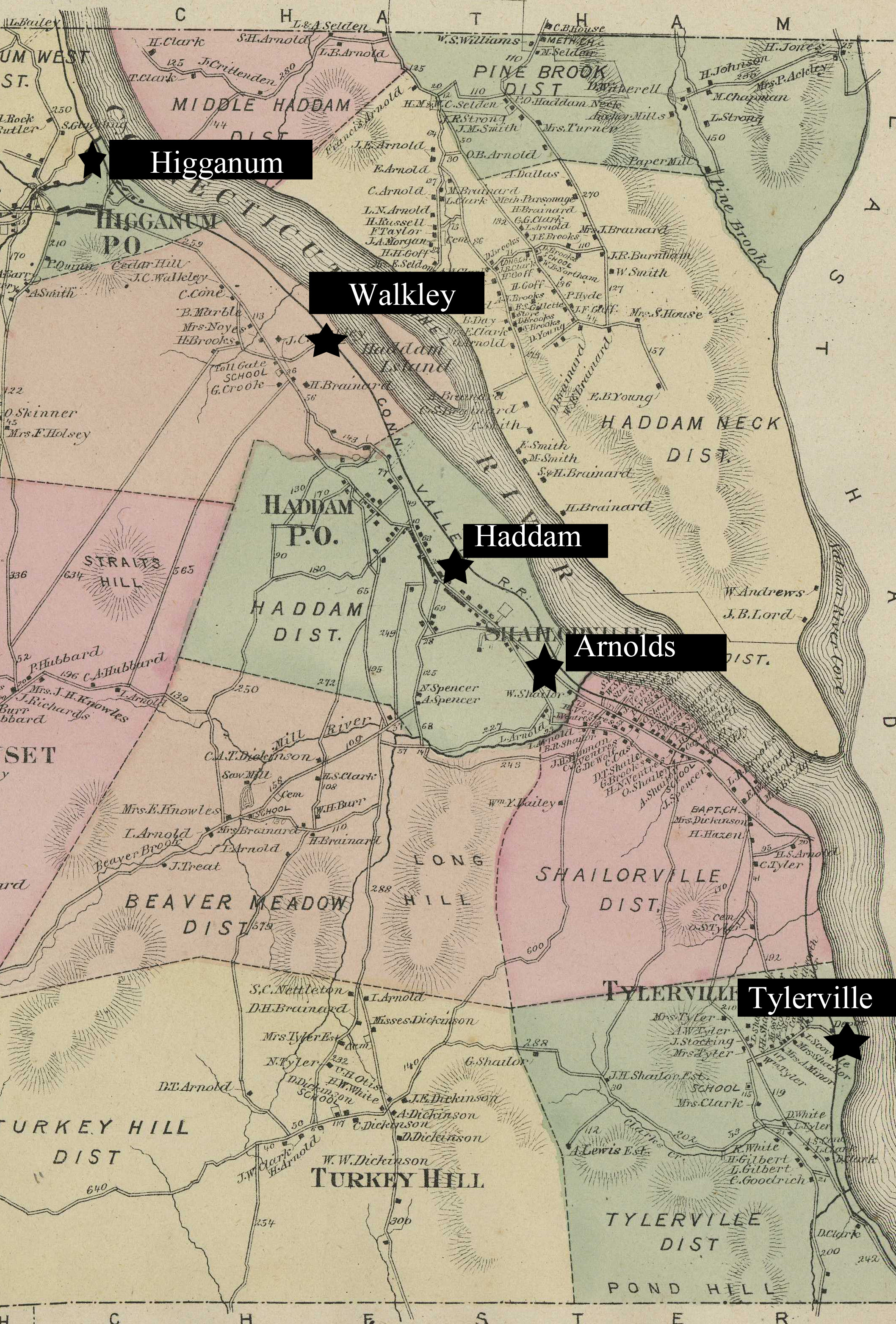
Prior to the railroads, modes of transportation included walking, river boats, horse drawn carts, and sleighs. During the winter months the river froze, and deep snow prevented Haddam residents from getting much further than their local village church. Imagine not being able to leave Shailerville for three months of the year! The railroad introduced year-round travel to the residents of Haddam for the first time.
Starting at the south end of town and heading north, there was the Goodspeed Station, serving the Tylerville section of town and the village of East Haddam. Then there was Arnolds Station, primarily a freight station but also serving the people of the Shailerville section town. Next was Haddam Station (the contested one) serving Haddam proper and the steam ship dock, most used as a passenger station. Next to the north was the Walkley Station, named for James C. Walkley, one of the chief financers of the railroad’s construction and the first Vice-President of the railroad. It served as his station but also for the people of Haddam Neck. Lastly there was the Higganum Station, serving that section of town with one building used both as a passenger station and as a freight house.
The Goodspeed Station
The Goodpeed Station served the Tylerville section of Haddam along with East Haddam and Moodus via a ferry across the river and after 1913, the swing bridge. In February of 1912, the station was renamed East Haddam-Moodus but was later returned to its original name of Goodspeed.
 There have been three passenger stations at Goodspeed yard on the same footprint. The first was a two-story building with the station on the first floor and boarding for railroad and ferry workers on the second floor. That station burned down on February 5, 1897, as a result of a dynamite explosion during a night robbery. It was replaced by a one-story station with a large roof covering the boarding platform, built in April of the same year. That building was torn down in August of 1939 after the end of passenger service in 1933.
There have been three passenger stations at Goodspeed yard on the same footprint. The first was a two-story building with the station on the first floor and boarding for railroad and ferry workers on the second floor. That station burned down on February 5, 1897, as a result of a dynamite explosion during a night robbery. It was replaced by a one-story station with a large roof covering the boarding platform, built in April of the same year. That building was torn down in August of 1939 after the end of passenger service in 1933.
In 2000, the passenger station from North Chester, which was erected in 1871, was saved from demolition and moved by rail to Tylerville. It was placed within the footprint of the earlier passenger stations and is now used as a track maintenance building.
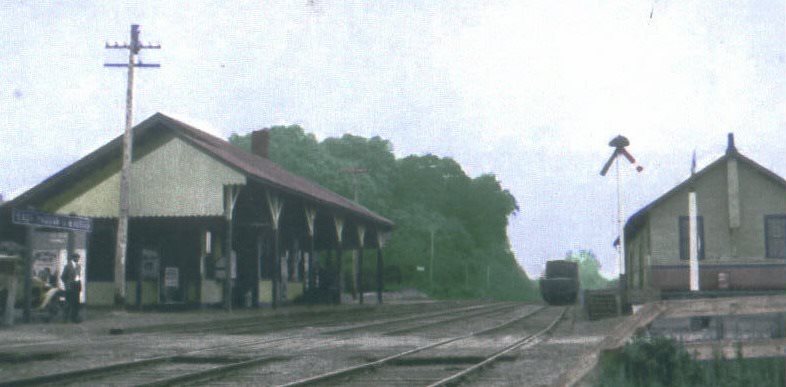 Goodspeed Station housed the Tylerville Post Office as many train stations did at the time. The Postmaster from East Haddam would travel across the river every day to get the mail from the trains too. Before the bridge, he would take a boat, but in the winter, he had to walk across the ice, with his mail bag over his shoulder carrying a long pole held horizontally in his hands to save himself in case the ice broke, and he fell through.
Goodspeed Station housed the Tylerville Post Office as many train stations did at the time. The Postmaster from East Haddam would travel across the river every day to get the mail from the trains too. Before the bridge, he would take a boat, but in the winter, he had to walk across the ice, with his mail bag over his shoulder carrying a long pole held horizontally in his hands to save himself in case the ice broke, and he fell through.
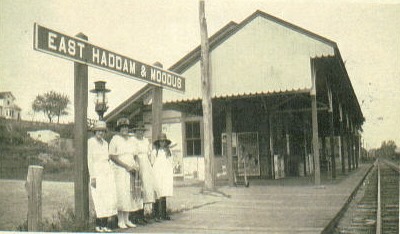 The original freight house on the east side of the tracks still exists today. One of the primary goods, the Goodspeed freight house handled, was cotton brought up from the south by the railroad and then transported to the twine mills on the Moodus River by wagon. Later, lumber for Moodus Lumber was transloaded at Goodspeed yard. As the freight business declined on the line, the freight house was sold and became Yantic Feed Company in the 1960s. Later in the 1980s, it became an outdoor sporting goods store selling canoes among other things. The building later became the Goodspeed’s Station Country Store, the gift shop that is currently located there today.
The original freight house on the east side of the tracks still exists today. One of the primary goods, the Goodspeed freight house handled, was cotton brought up from the south by the railroad and then transported to the twine mills on the Moodus River by wagon. Later, lumber for Moodus Lumber was transloaded at Goodspeed yard. As the freight business declined on the line, the freight house was sold and became Yantic Feed Company in the 1960s. Later in the 1980s, it became an outdoor sporting goods store selling canoes among other things. The building later became the Goodspeed’s Station Country Store, the gift shop that is currently located there today.
Arnolds Station
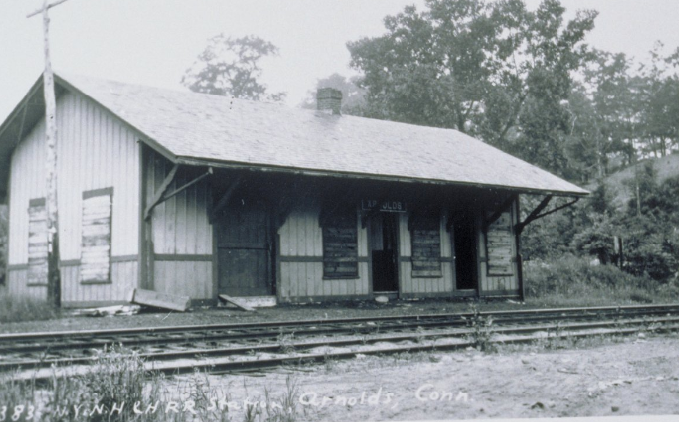 This station was located just to the north of the high bridge over the Mill River by Spencer’s Shad Shack. It was the main passenger station for the Shailerville section of town, but the main freight station for Haddam.
This station was located just to the north of the high bridge over the Mill River by Spencer’s Shad Shack. It was the main passenger station for the Shailerville section of town, but the main freight station for Haddam.
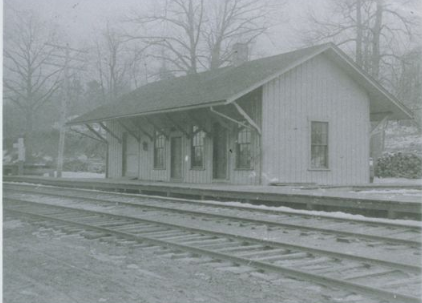 Arnolds Station was originally intended to be the main Haddam village station. It was located conveniently between Haddam and Shailerville and close to the rail line that came down from the Arnold granite quarry. However, Haddam citizens petitioned the Connecticut Valley Railroad for a station to be located directly east of the County Jail on the road leading to Red Store Dock approximately three-quarters of a mile to the north. The Railroad Directors gave Isaac Arnold, Esq. permission to erect a depot at the original site at a price not exceeding $2000 and if “satisfactory” the company at the end of two years would take ownership of the building at cost.
Arnolds Station was originally intended to be the main Haddam village station. It was located conveniently between Haddam and Shailerville and close to the rail line that came down from the Arnold granite quarry. However, Haddam citizens petitioned the Connecticut Valley Railroad for a station to be located directly east of the County Jail on the road leading to Red Store Dock approximately three-quarters of a mile to the north. The Railroad Directors gave Isaac Arnold, Esq. permission to erect a depot at the original site at a price not exceeding $2000 and if “satisfactory” the company at the end of two years would take ownership of the building at cost.
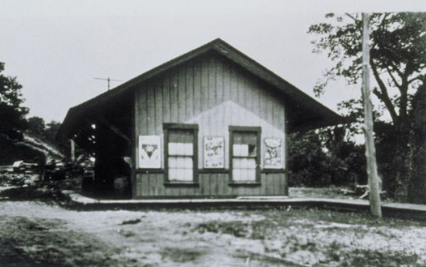 Haddam granite was the major export from this station. It was brought down from the quarry by a two-foot gauge railroad and transloaded by derrick crane onto rail cars. The derrick crane was located to the north of the station and the road crossing on top of a granite loading dock.
Haddam granite was the major export from this station. It was brought down from the quarry by a two-foot gauge railroad and transloaded by derrick crane onto rail cars. The derrick crane was located to the north of the station and the road crossing on top of a granite loading dock.
A big import for this station was coal, which was offloaded into bins next to the coal track. The coal was then sold to the Haddam residents for home heating, popular in the Victorian period and up until the 1950s.
Haddam Station
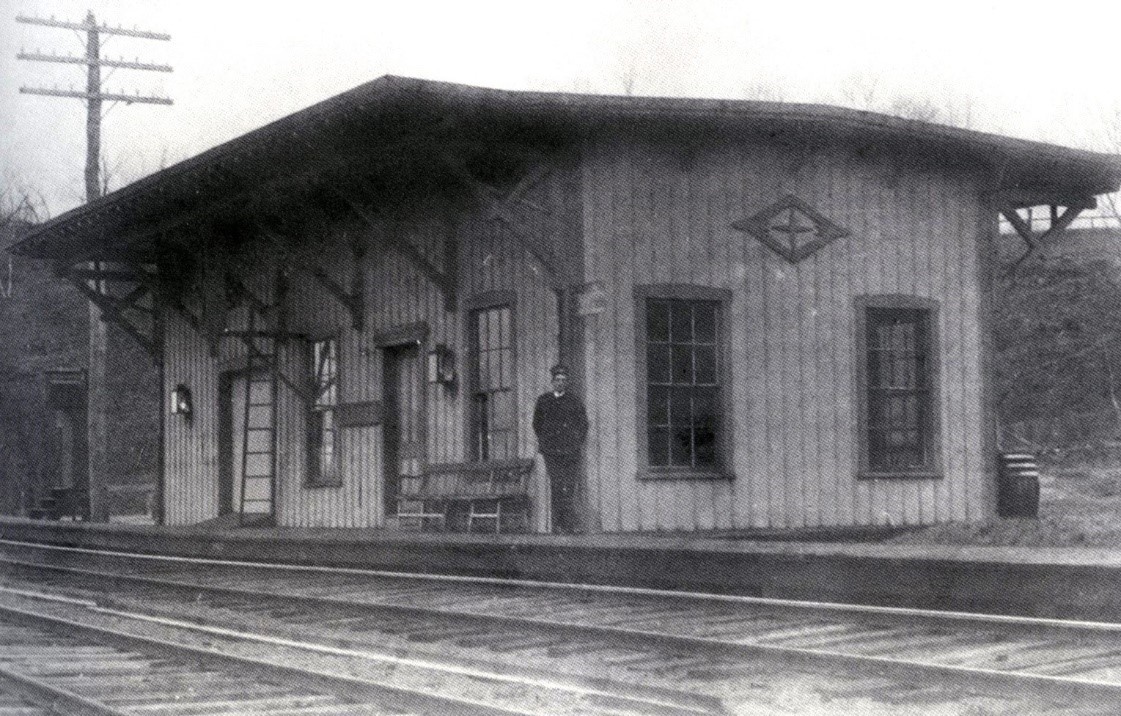
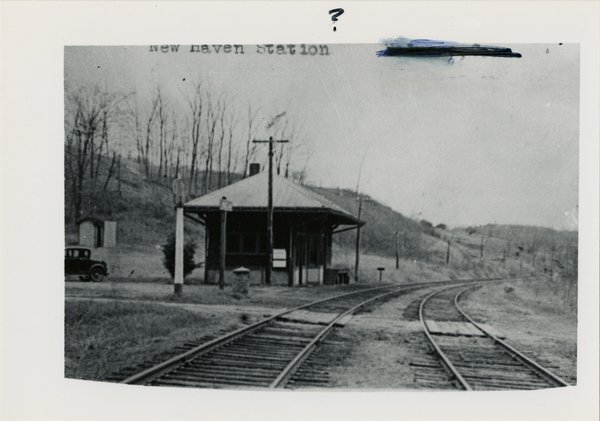 When the Valley Railroad was designing its line, it did not originally locate a station here. However, the people of Haddam wanted a passenger station closer to the center of town than the station that was to become Arnolds. During a meeting in September of 1871, the railroad conceded to having a fifth station in town, which would be named “Haddam.”
When the Valley Railroad was designing its line, it did not originally locate a station here. However, the people of Haddam wanted a passenger station closer to the center of town than the station that was to become Arnolds. During a meeting in September of 1871, the railroad conceded to having a fifth station in town, which would be named “Haddam.”
Second Haddam Station, right.
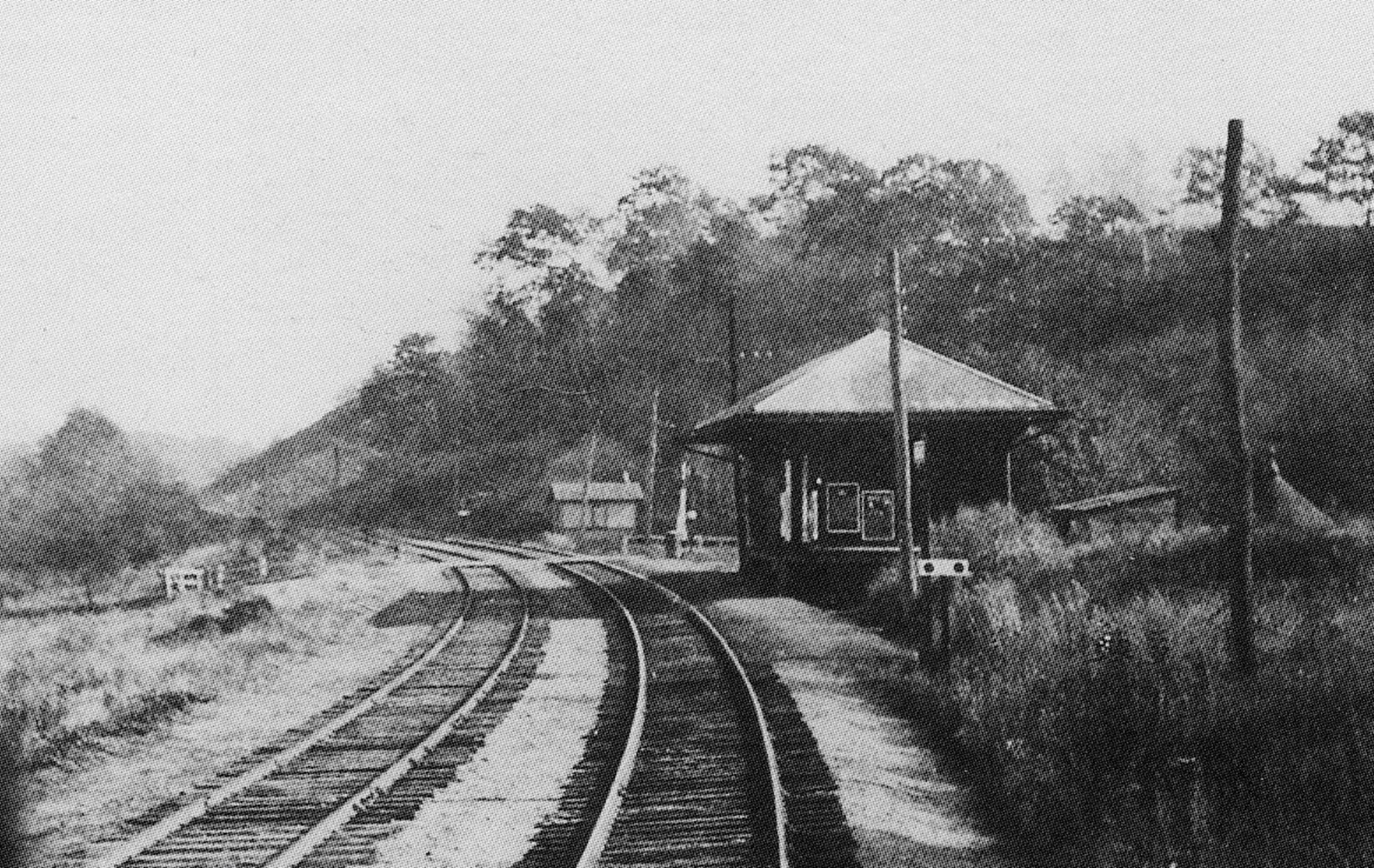 The Haddam Station sat at the bottom of Station Hill Road which was located across the street from the Middlesex County Jail. Station Hill Road crossed the two tracks at the station and continued down to the steamship landing. This was located where the Haddam Meadows boat launch is today. What was once a busy street, with a train station, stores, and docks, is not much more than a footpath today.
The Haddam Station sat at the bottom of Station Hill Road which was located across the street from the Middlesex County Jail. Station Hill Road crossed the two tracks at the station and continued down to the steamship landing. This was located where the Haddam Meadows boat launch is today. What was once a busy street, with a train station, stores, and docks, is not much more than a footpath today.
Second Haddam Station, right.
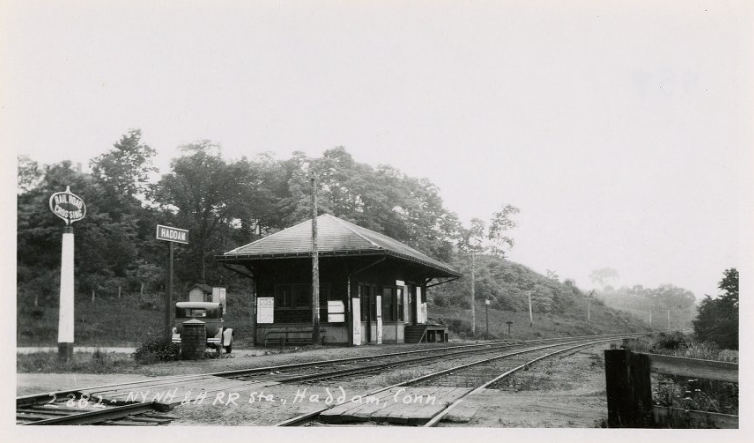 Haddam Station served as mostly a passenger station and post office. A fire destroyed the original station in March of 1914 which was replaced with a smaller station. It was dismantled after passenger service ended in 1933. The passing track was removed then as well, but the timber for the switches remains on both ends of where it was.
Haddam Station served as mostly a passenger station and post office. A fire destroyed the original station in March of 1914 which was replaced with a smaller station. It was dismantled after passenger service ended in 1933. The passing track was removed then as well, but the timber for the switches remains on both ends of where it was.
Second Haddam Station, right.
Walkley Station
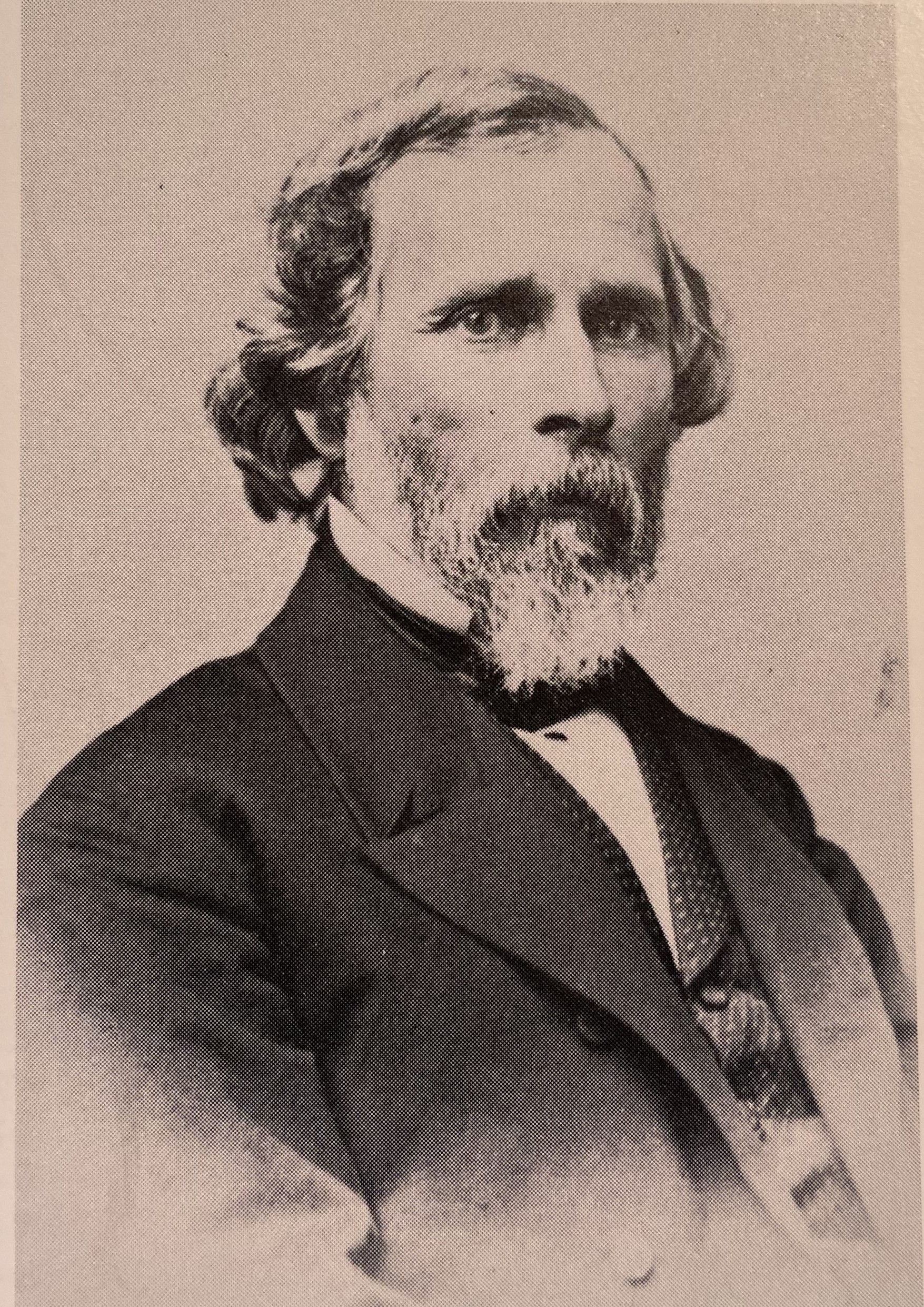 This station served James C. Walkley and the residents of the Haddam Neck section of town, across the river. The station building, which stood on the west side of the track, was built by Mr. Walkley, but only lasted until 1887 when it was destroyed by fire on November 5 of that year and never rebuilt. It is the only station -of which no known photos exist. The site of the station is partially buried by fill used to construct Route 9 (now Route 154) in 1930. A water column stood to the north of the station on the west side of the tracks. It was the only water tower between Old Saybrook and Middletown. The brick foundation of the wooden water tank is all that remains today. The water tank was filled by a gravity fed pipe that came down the hill from a pond on the Walkleys’ property.
This station served James C. Walkley and the residents of the Haddam Neck section of town, across the river. The station building, which stood on the west side of the track, was built by Mr. Walkley, but only lasted until 1887 when it was destroyed by fire on November 5 of that year and never rebuilt. It is the only station -of which no known photos exist. The site of the station is partially buried by fill used to construct Route 9 (now Route 154) in 1930. A water column stood to the north of the station on the west side of the tracks. It was the only water tower between Old Saybrook and Middletown. The brick foundation of the wooden water tank is all that remains today. The water tank was filled by a gravity fed pipe that came down the hill from a pond on the Walkleys’ property.
James C. Walkley, right.
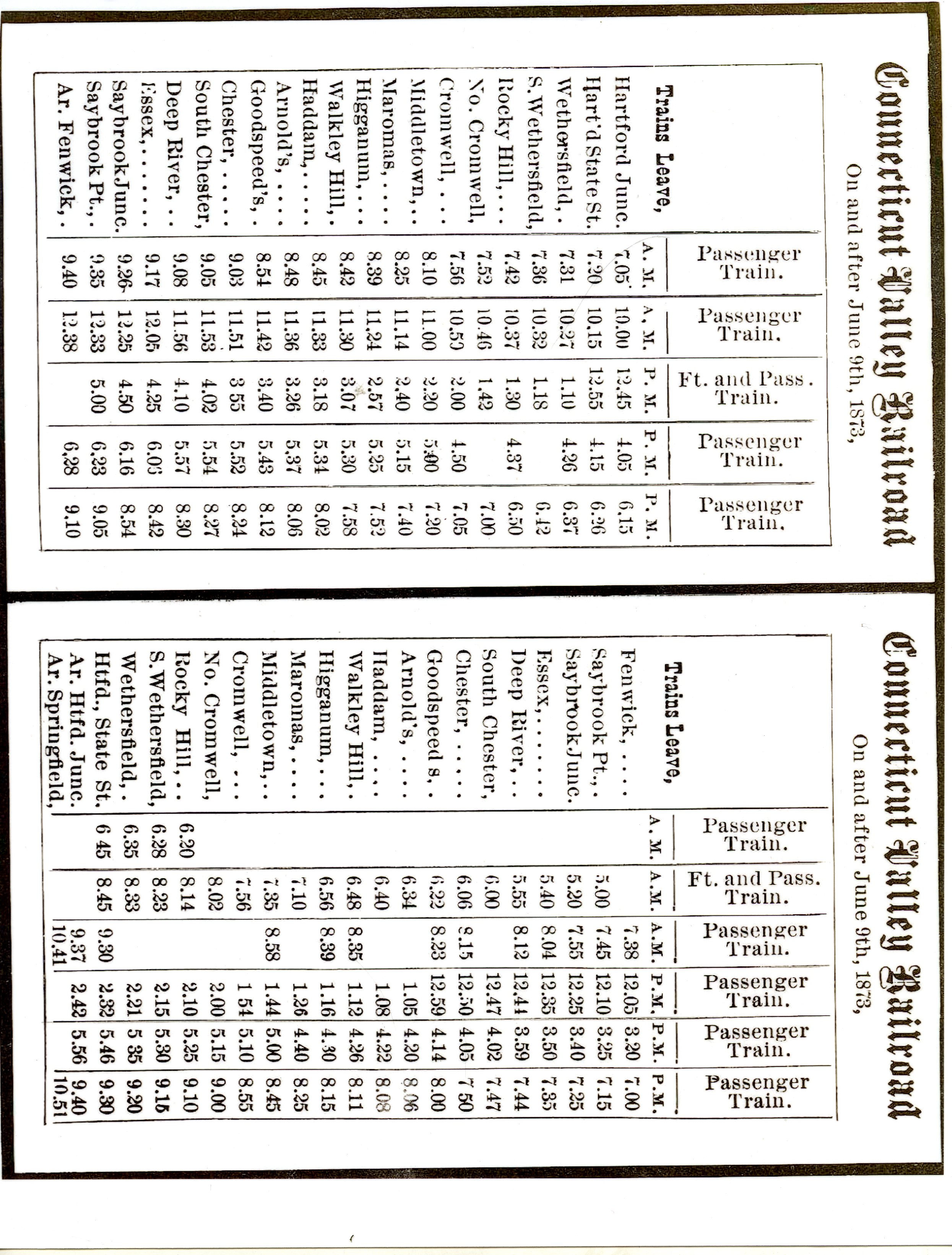 This was a very small station, called a flag stop. At stations where there was no station agent, trains would not regularly stop. One would wave a flag to hail down the train. Those coming from Haddam Neck could buy their train tickets from the steamship landing at Rock Landing on the east side of the river but had to make their own way across the river to get the train. Only the Walkley family used the station from the west side. It was directly down the hill behind the Walkley mansion on Walkley Hill Road.
This was a very small station, called a flag stop. At stations where there was no station agent, trains would not regularly stop. One would wave a flag to hail down the train. Those coming from Haddam Neck could buy their train tickets from the steamship landing at Rock Landing on the east side of the river but had to make their own way across the river to get the train. Only the Walkley family used the station from the west side. It was directly down the hill behind the Walkley mansion on Walkley Hill Road.
Connecticut Valley Railroad Timetable.
Higganum Station
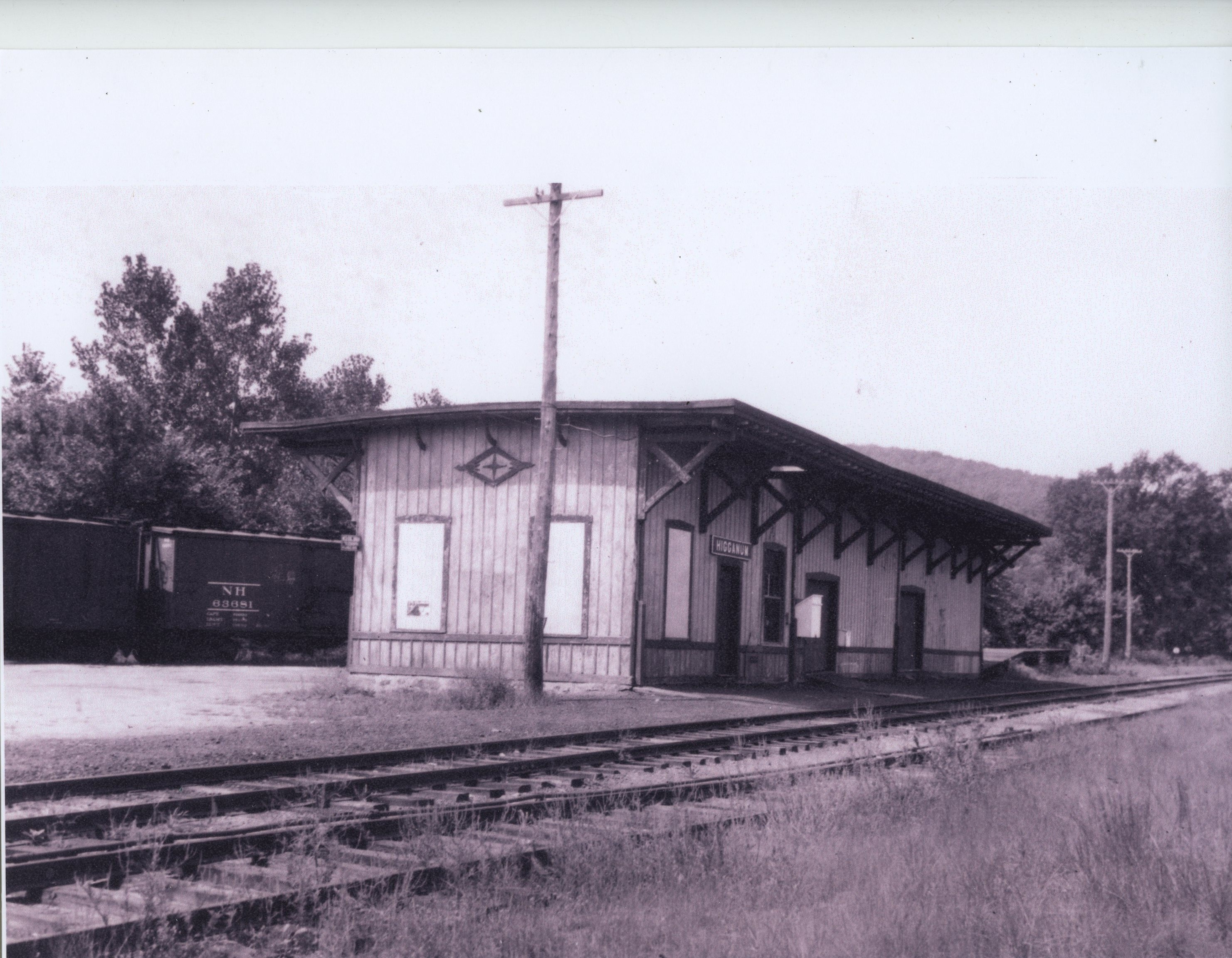
Higganum Railroad Station
Higganum Station stood at the bottom of Depot Hill Road near Higganum center. The railroad company built the north end of Depot Hill Road (which passes the Cutaway Harrow site and Dublin Hill Road) to access the station as the portion from the Landing Road area was too steep for wagons.
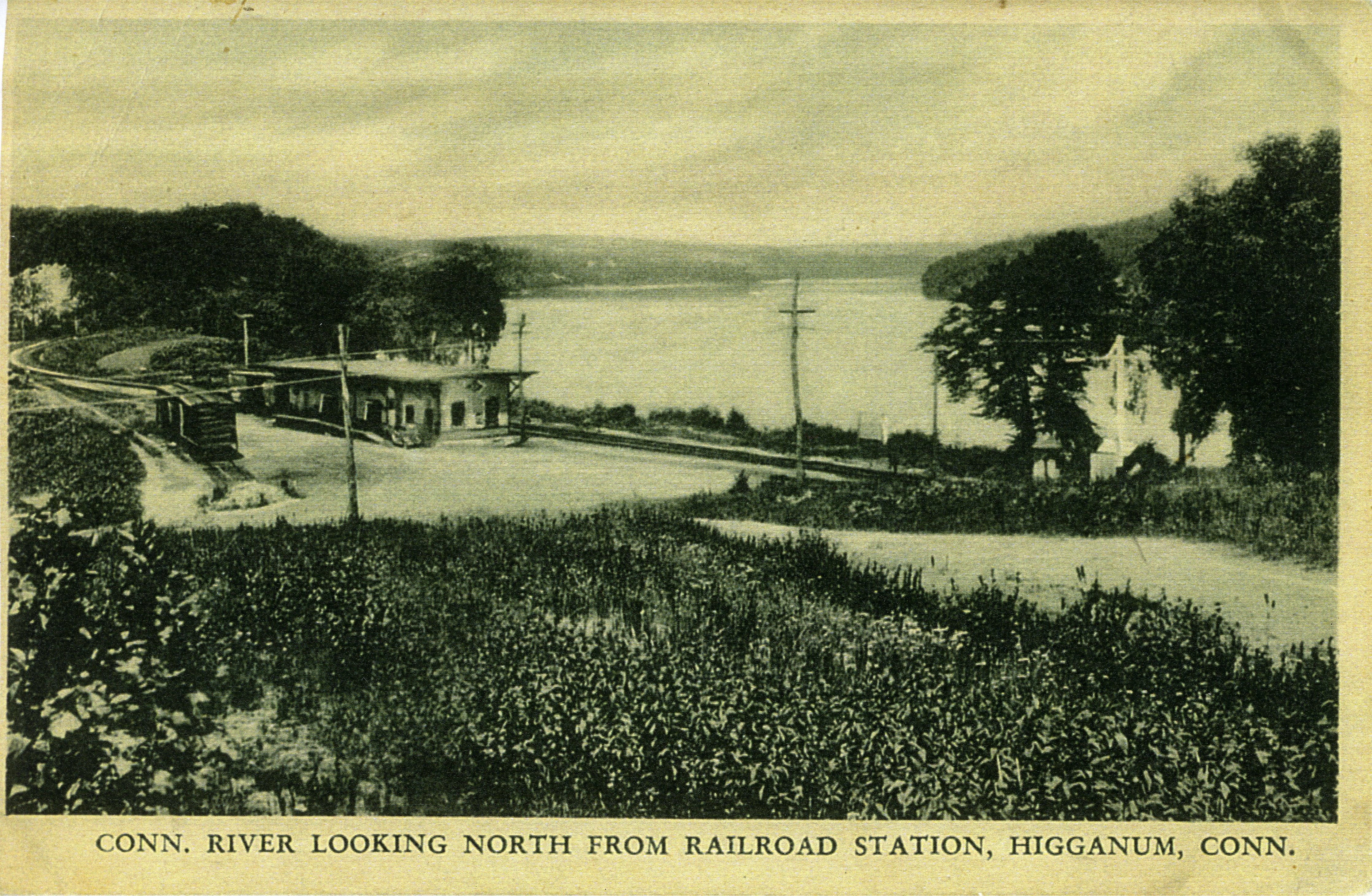 The Higganum Station served as both a freight and passenger station. The station was busy, handling various shipments for local businesses which would be delivered to the “house track” located behind the station. This house track, some of which is still there in the grass, was used for loading lumber from the sawmill in Higganum. This stop was the last to operate on the line in Haddam, remaining active right up to the end of service in 1968. Rossi Lumber made railroad ties that were shipped out in gondola cars from this station. The switch to that track was taken out in the early 1970s.
The Higganum Station served as both a freight and passenger station. The station was busy, handling various shipments for local businesses which would be delivered to the “house track” located behind the station. This house track, some of which is still there in the grass, was used for loading lumber from the sawmill in Higganum. This stop was the last to operate on the line in Haddam, remaining active right up to the end of service in 1968. Rossi Lumber made railroad ties that were shipped out in gondola cars from this station. The switch to that track was taken out in the early 1970s.
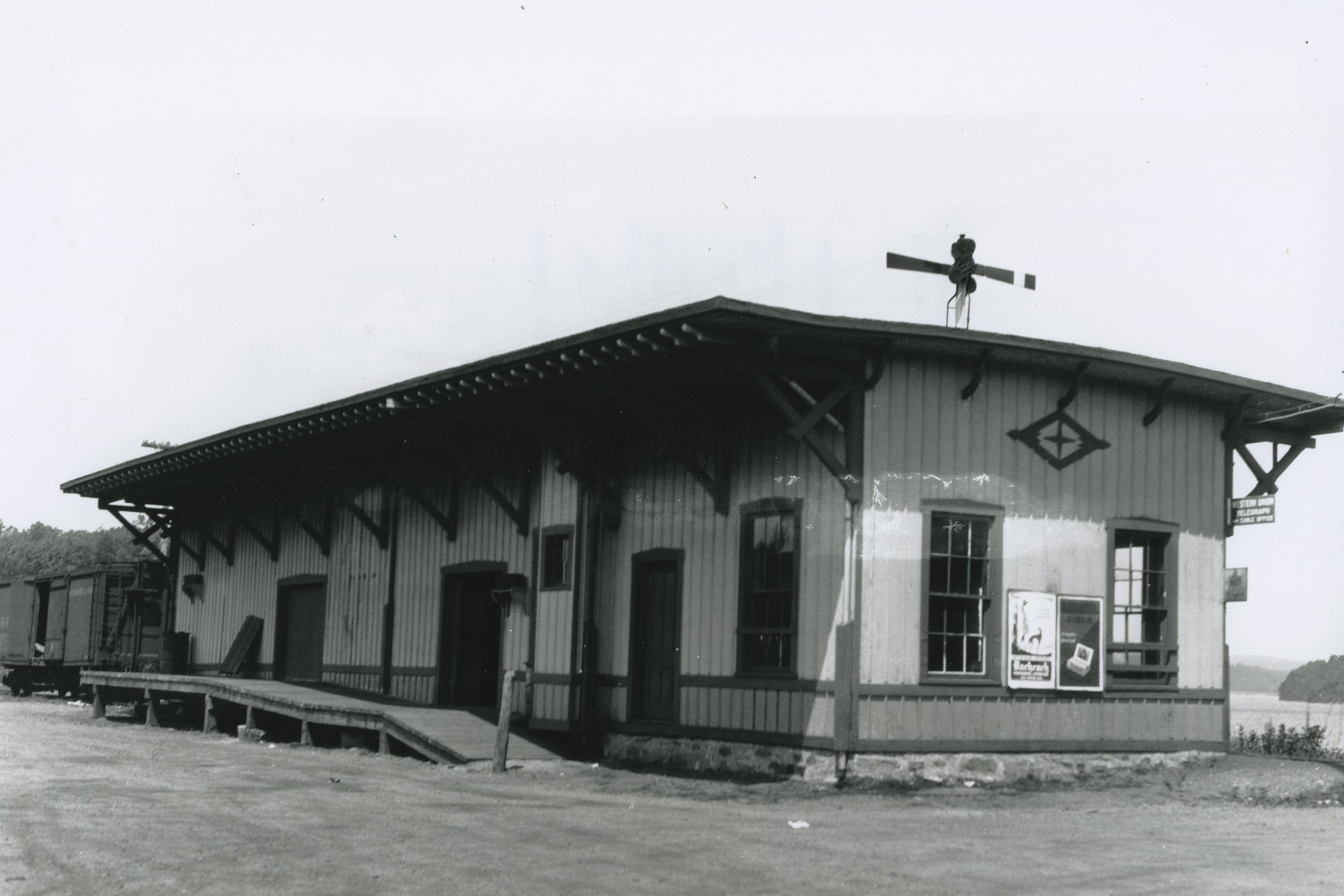 One prominent delivery at this station was the arrival of Haddam’s first fire truck, a 1930 Pirsch. This fire truck is still used in parades today. It was delivered in 1930 in a New York Central boxcar with end doors, designed to carry automobiles. The box car was parked on the house track, and a ramp made of railroad ties was constructed to drive the new fire engine out of the car and down to the road.
One prominent delivery at this station was the arrival of Haddam’s first fire truck, a 1930 Pirsch. This fire truck is still used in parades today. It was delivered in 1930 in a New York Central boxcar with end doors, designed to carry automobiles. The box car was parked on the house track, and a ramp made of railroad ties was constructed to drive the new fire engine out of the car and down to the road.
Higganum Station caught fire in the 1960s, and much of the building was destroyed. The surviving section remained until 1969 when it was torn down.
Thank you to Brendan Matthews, Max Miller and Bill Schneider for their contributions.
